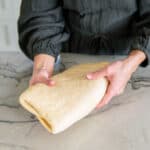Plunderteig (German Croissant Dough)
Plunderteig is a German pastry dough that's flaky and similar to croissants, but without quite as many layers aka this dough is less work! The butter-laminated yeast dough ends up being a bit more compact than croissant dough, perfect for danishes. Homemade Plunderteig is like a blank canvas for your creativity and the basis for many German pastries or danishes like the best Franzbrötchen (German cinnamon rolls).Makes 10 to 12 large pastries.
Servings: 12 pastries
Calories: 354kcal
Equipment
- 1 Rolling Pin for rolling out the dough
- 1 Kitchen Scale optional
- Parchment Paper for rolling out the butter plate
- Plastic Wrap or gallon-sized freezer bag for storing the dough in the fridge in between laminations.
Ingredients
Plunderteig Dough
- 500 grams flour I use an organic all purpose flour
- 10 grams salt
- 40 grams sugar
- 300 milliliters milk Luke warm
- 5 grams active-dry yeast
Butter Plate
- 225 grams butter Room temperature. I use grass-fed butter and think it really makes a difference in taste.
- 30 grams flour
Instructions
- Combine the yeast and Luke warm milk and let stand for 5 minutes or until starting to get bubbly. Mix together with other dough ingredients and knead until you have a smooth, elastic dough. Chill in the fridge for 30 minutes.500 grams flour, 10 grams salt, 40 grams sugar, 300 milliliters milk, 5 grams active-dry yeast
- Mix the room temperature butter and flour for your butter plate, then roll it out in between two sheets of parchment paper to be a rectangle shape and no more then ¼ inch thick (about ½ cm). Chill it in the fridge for about 30 minutes to an hour. I actually chill mine in the freezer for 15 to 20 minutes or until the yeast dough is rolled out and ready for my butter plate.225 grams butter, 30 grams flour
- Roll out the yeast dough into a rectangle shape and large enough to perfectly envelope the butter plates from all sides. You want the dough to generously overlap on the seams and no butter should be peaking through.
- Simple Lamination. Roll out the packaged butter plate long ways and fold the top down and the bottom up, creating 3 overlapping layers of dough. Wrap in plastic and chill for one hour (or more if your kitchen is warmer).
- Double Lamination. Roll out the dough again into an even longer rectangle, then fold the top down into 2 layers, meeting halfway AND the bottom up into 2 layers, meeting halfway. This process creates 4 layers. Wrap in plastic and chill for one hour.
- Simple Lamination. Now repeat step 3 and chill again for another hour.
- Your dough is ready to be rolled out to be about ¼ inch thick (½ cm) and used for the German pastries of your dreams like my Franzbrötchen (German cinnamon rolls).
- When ready to bake your pastries, shape them first. Then let them sit at room temperature for another 30 minutes to an hour (or until wiggly when gently shaking the baking sheet). Brush on an egg wash made from equal parts of egg yolk and water. Bake for 12 to 15 minutes at 350 convection setting.
Video
Notes
It helps to watch my video for the lamination steps and to refer to the graphic step-by-step image in my blog post, to really get a good grip on the process of working the layers of butter into the dough.
Here some more tips:
- When in doubt, chill: And I mean it. This is not a dough you want to rush. If the butter gets too soft, it likes to tear up the dough and make its way through. Not cool. What's cool is giving the dough some extra time to chill and stay compact.
- Dough Is tearing: If you witness any kinds of tearing of the dough and butter peaking through, STOP and put it back in the fridge for another hour.
- Work ahead: I have made the main dough (up to step 3 on my chart) the day before, then let it rest overnight and continued the next day. I have also chilled the dough overnight ready to be rolled out (up to step 4 on the chart), and that worked great, too! This comes in handy when wanting to make fresh pastries for breakfast the next morning!
- Freezing Plunderteig: If freezing your Plunderteig, make sure you're rolling it out completely, then dust it in flour, wrap it in plastic and freeze it on a baking sheet. The day before using it, transfer the dough to the fridge. When ready to use roll out a little bit if needed, then cut out your pastries.
Nutrition
Calories: 354kcal | Carbohydrates: 5g | Protein: 1g | Fat: 37g | Saturated Fat: 24g | Polyunsaturated Fat: 1g | Monounsaturated Fat: 10g | Trans Fat: 1g | Cholesterol: 100mg | Sodium: 541mg | Potassium: 45mg | Fiber: 0.1g | Sugar: 3g | Vitamin A: 1164IU | Vitamin C: 0.001mg | Calcium: 35mg | Iron: 0.1mg
